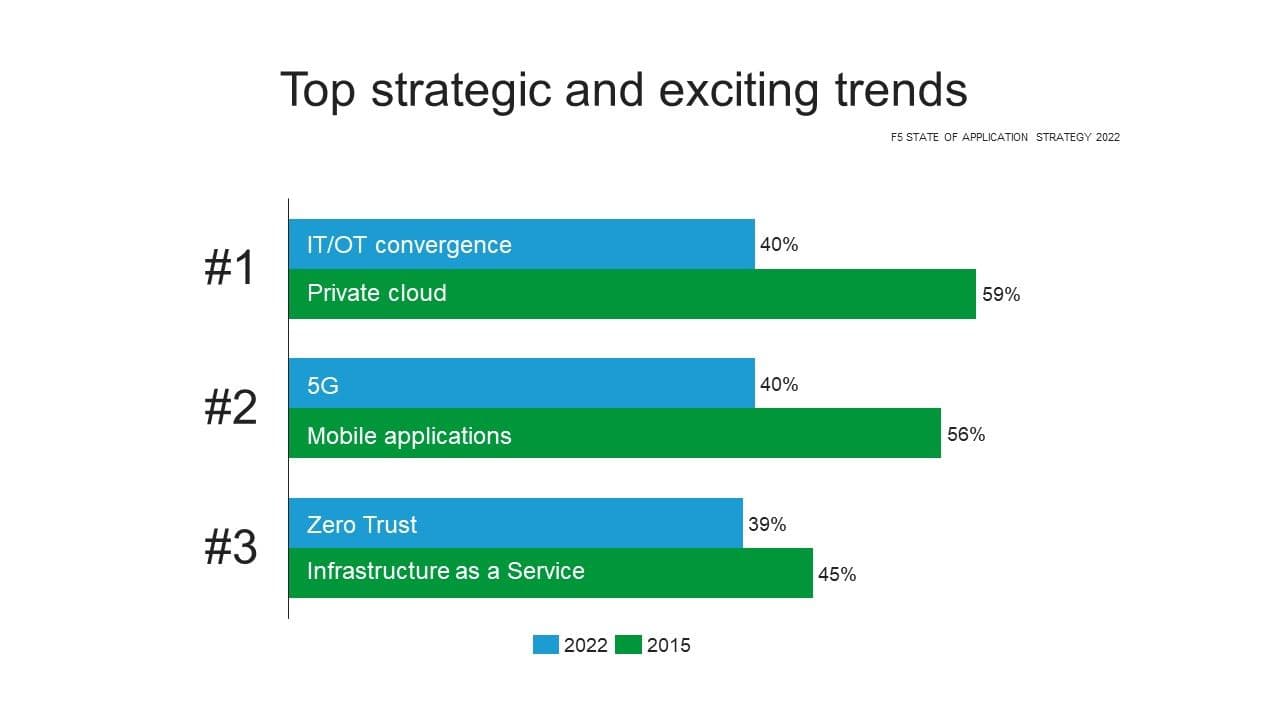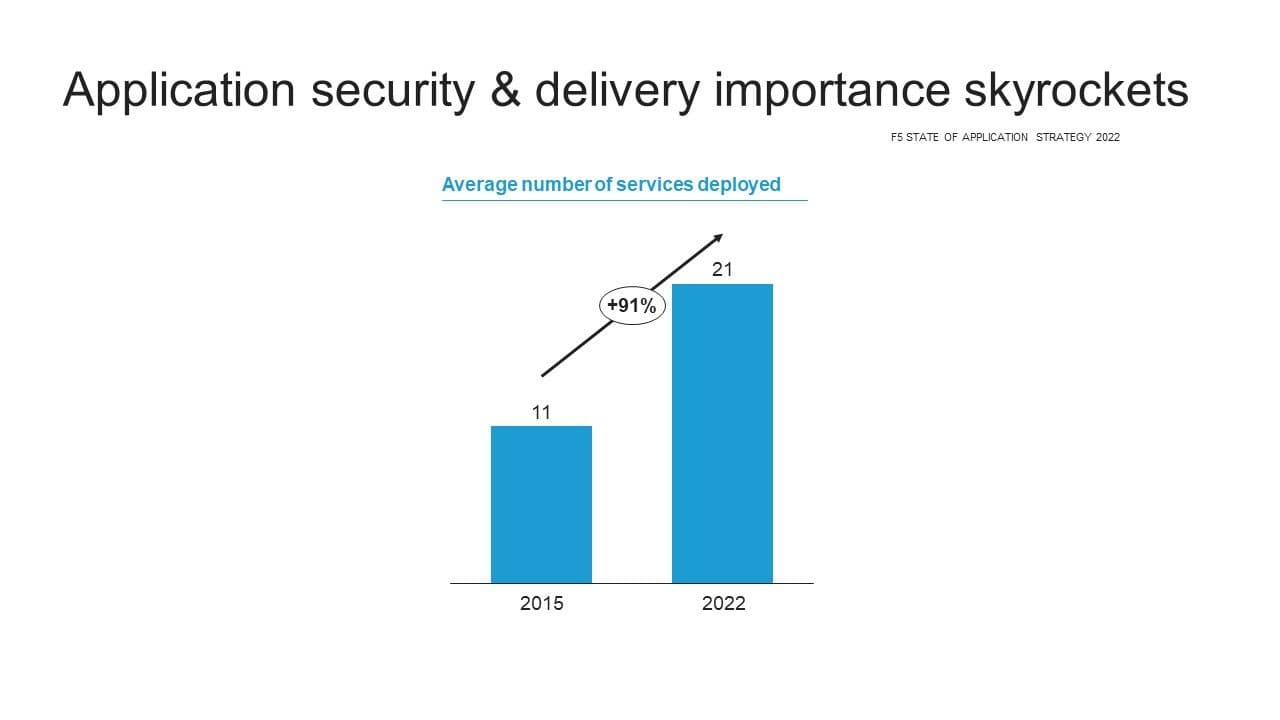Gosh, has it really been that long?
At F5, I’ve had the privilege of learning from and working with some of the best in tech, and in particular the good fortune of collaborating with Lori MacVittie on The State of Application Strategy for the past 8 years. As colleagues such as Keiichiro Nozaki have pointed out, it is only fitting that this blog acknowledges the Chinese lucky number 8, as F5’s Asia Pacific teams have championed this research and contributed to the richness of its analysis through the years.
I remember the first year we went global and found out that our Asia Pacific respondents were paving the path to public cloud much faster than the Americas and EMEA regions. Over the years, we have learned to keep an eye out in Australia/New Zealand for new trends in open source and microservices. China, India, and Singapore shined a light on the promise of digital transformation with SuperApps like WeChat, Alipay, and Grab.
Strategic trends
Eight years ago, the industry was in the early stages of digital transformation and the top strategic trends reported were private cloud (59%), mobile applications (56%), and SaaS (48%). This was in the early days of mobile applications transforming our lives, when we could use our phone to show our boarding passes—what a revelation not to have to print a ticket! Today, mobile apps have transformed the front-end experiences for every aspect of our lives, from ordering take out, signing up for classes, and scheduling personal appointments. But the future calls and organizations are now looking to the next horizon for digitizing not only the front end but optimizing back-end processes of the business, inclusive of finance, manufacturing, and all the functions that make an organization run. As a result, the number-one exciting trend this year is Information Technology (IT) and Operational Technology (OT) convergence, bringing the vast amount of manufacturing devices, sensors, and vehicles onto the network and transforming the way we do business. As the number-one answer at 40% of respondents, this is a dramatic 82% increase from 2015 when 22% of respondents reported Internet of Things (IoT) as a strategic trend.
Likely one of the reasons the respondents are excited over IT/OT convergence is because they are also excited about the possibilities enabled by 5G. The 5th generation global mobile network standard is meant to deliver higher multi-Gbps peak data speeds, ultra-low latency, and massive network capacity to support the explosion of apps, data, and things on the network. Statista reports the 5G IoT endpoint installed base will explode from 3.5 million devices in 2020 to 49 million in 2023. In a digital business, it is digital conditions that require a reaction, and organizations are preparing to collect and understand the digital signals that these millions of devices send to deliver growth, reduce risk, and improve efficiencies in the business.

Another indication that we are in a new era is the maturity in interest of the cybersecurity market. Zero trust was the leading security trend, but it was followed closely by Web Application and API Protection (WAAP) and Secure Access Service Edge (SASE). All in all, 74% of respondents choose at least one of these security technologies that they are excited about. This speaks to the importance of security for all roles (not just security professionals) and the need to think about security in the context of reducing risk and supporting trust in the organization as a whole.
Application security and delivery technologies
As organizations mature in their digital transformation journey, application security and delivery technologies are emerging as a core capability in a digital world. The average number of technologies deployed increased 91% since 2015, from 11 to 21. We have learned that our most precious digital assets—apps—need a full range of helpers under the umbrella categories of performance, availability, security, and identity.

The use and proliferation of application security and delivery technologies result from the combination of capabilities supporting the goals of the business. 79% of respondents told us that app services are important to the user experience. Beyond delighting end users with seamless digital interactions, app services support the digital operations platform. 82% report that the telemetry and insights that app services deliver are very important to meeting service level objectives of organizations. Collecting, processing, and analyzing operational data (telemetry) from every system, service, and platform that supports an application enables IT and the business to work together in lockstep.
Public cloud realities
Over time, we’ve found that respondents are realistic about their use of public cloud. Back in 2017, the consensus was that most organizations believed about 20% of apps would be in the public cloud, and this year 17% of apps were reported in the public cloud. Demonstrating a sensible balance of excitement between new operating models and the reality of critical application investments in on-premises data centers.
All regions agree on the importance of data and insights in preventing cyber attacks
Digital transformation touches every corner of the globe and over the years we can see trends that start in one region carry over to others. When we look at site reliability engineering (SRE) practices, 95% of EMEA respondents have adopted or plan to adopt compared to 92% in North America and only 56% in Asia Pacific. However, Australia/New Zealand again lead the region with modern operations principles here, with 90% reporting adoption and plans. Asia Pacific leads in the use of AI and ML for security. All regions agree on the importance of security and that the most valuable use of data and insights surrounding applications is tied to notification of possible attacks on the app.
The future state of application security and delivery is adaptive. Business value will be achieved by ensuring that app performance, availability, and security will adapt with the least amount of human intervention possible. Just over half (52%) of respondents told us they plan to use AI to drive operations (AIOps). We think this percentage will skyrocket in the coming years as AIOps matures to create safe exceptional digital experiences.
We are so grateful for your time and insights these past eight luck-infused years that have powered our research, and we’re excited to continue exploring the emerging application security and delivery technologies that will deliver the insights and automation needed for contemporary digital operations.
Check out related blogs for deeper dives on select topics:
State of Application Strategy 2022: Digital Innovators Highlight the Importance of Modernizing ›
State of Application Strategy 2022: Security Shifts to Identity ›
State of Application Strategy 2022: Edge Workloads Expanding to Apps and Data ›
State of Application Strategy 2022: Multi-Cloud Complexity Continues ›
State of Application Strategy 2022: Performance Trends ›
State of Application Strategy 2022: Time to Modernize Ops ›
State of Application Strategy 2022: The Future of Business Is Adaptive ›
About the Author

Related Blog Posts

Nutanix and F5 expand successful partnership to Kubernetes
Nutanix and F5 have a shared vision of simplifying IT management. The two are joining forces for a Kubernetes service that is backed by F5 NGINX Plus.

AppViewX + F5: Automating and orchestrating app delivery
As an F5 ADSP Select partner, AppViewX works with F5 to deliver a centralized orchestration solution to manage app services across distributed environments.

Build a quantum-safe backbone for AI with F5 and NetApp
By deploying F5 and NetApp solutions, enterprises can meet the demands of AI workloads, while preparing for a quantum future.

F5 ADSP Partner Program streamlines adoption of F5 platform
The new F5 ADSP Partner Program creates a dynamic ecosystem that drives growth and success for our partners and customers.
F5 NGINX Gateway Fabric is a certified solution for Red Hat OpenShift
F5 collaborates with Red Hat to deliver a solution that combines the high-performance app delivery of F5 NGINX with Red Hat OpenShift’s enterprise Kubernetes capabilities.
Phishing Attacks Soar 220% During COVID-19 Peak as Cybercriminal Opportunism Intensifies
David Warburton, author of the F5 Labs 2020 Phishing and Fraud Report, describes how fraudsters are adapting to the pandemic and maps out the trends ahead in this video, with summary comments.
